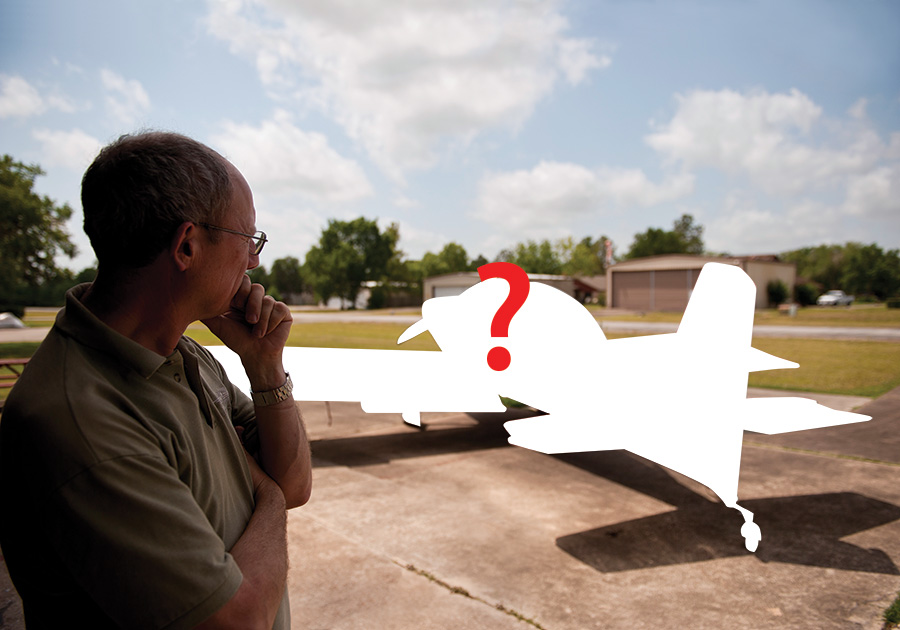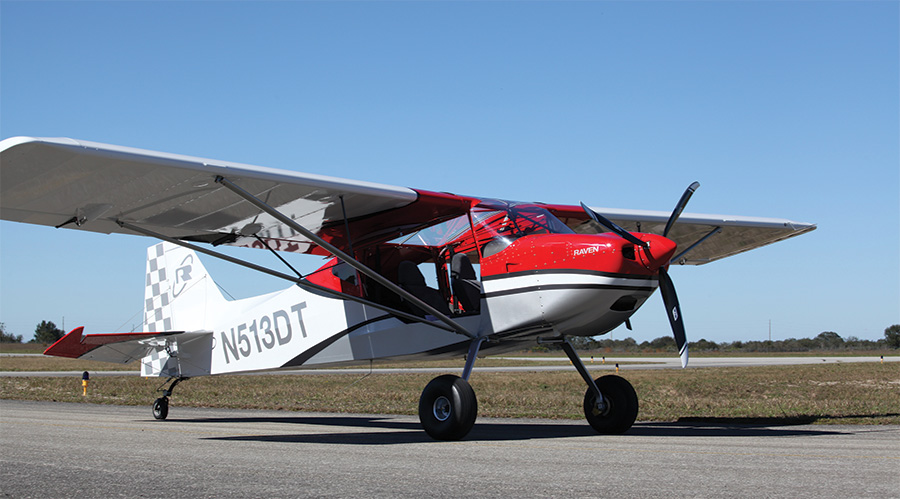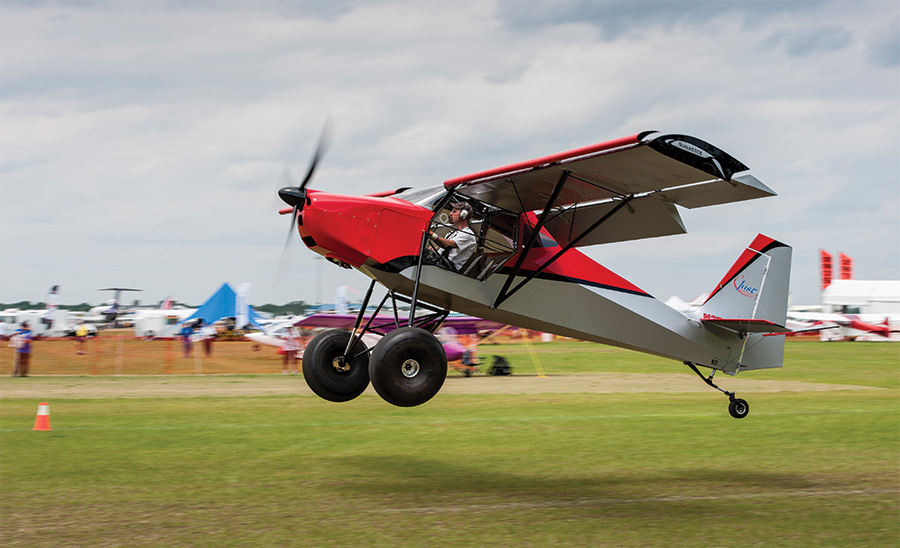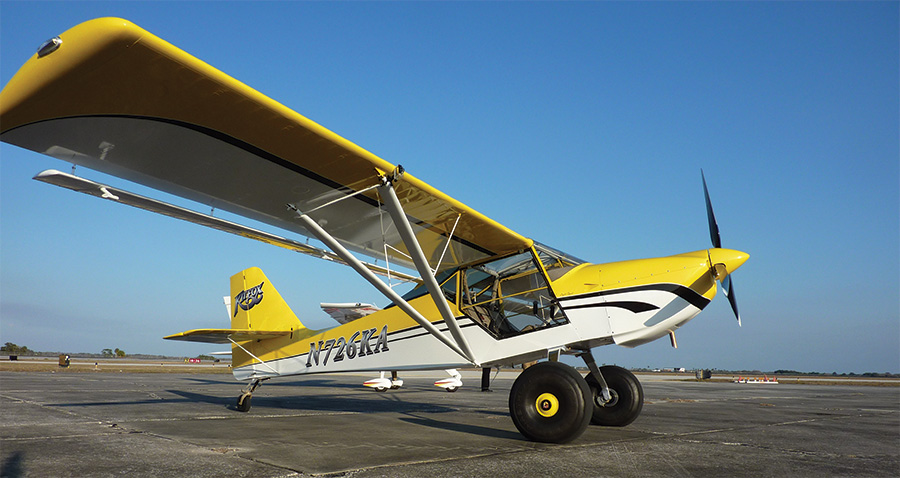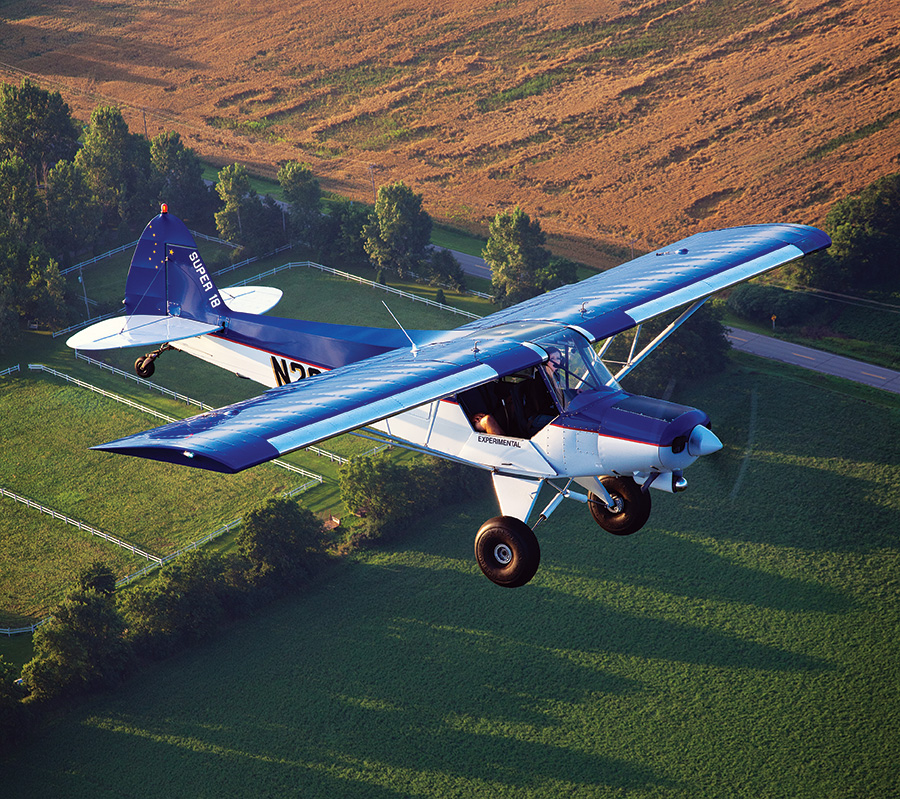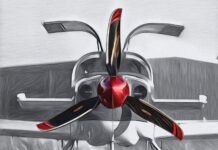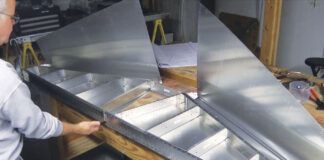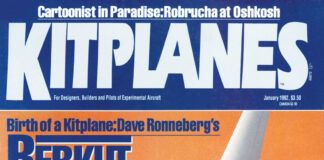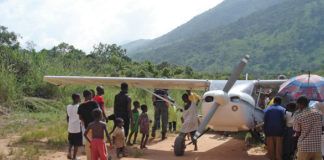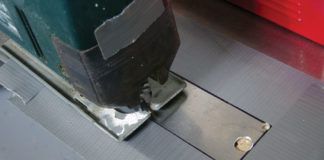Shopping for a homebuilt aircraft (or project) is a daunting task—there is no doubt about that. The goal with the annual Buyer’s Guide issue (and permanent online Buyer’s Guide) is to provide potential builders and buyers with basic information about a huge variety of aircraft kits and plans.
Yes, this information is important. But it’s only a start in the quest to find the right project or aircraft. It also takes a lot of detailed research to decide what to build for yourself—and much of that has to do with carefully defining your own requirements for an aircraft. But where do you start? What’s involved in figuring out exactly what it is you are shopping for? Here are some insights into the process—the trades and numerous choices that have to be made.
We Want a Bush Plane
Our goal was to build an aircraft for exploring the mountain and desert landing strips of the western United States. By “we” I mean myself and my wife—also a pilot, also a builder, and always looking for a new challenge. We have built before, of course. I have worked with most of the materials you will find in Experimental aviation, some much more than others. She has primarily built with metal, has dabbled with composites, and would like to try a different type of construction like tube and fabric.
Through a strange sequence of events and the vagaries of real life, we currently own three airplanes built from the kits of a common manufacturer—an RV-3, an RV-8, and an RV-6. All three go relatively fast, carry a decent payload, have excellent range, carry IFR avionics, and are aerobatic. How two people can require and occupy five aircraft seats is a mystery, but we find that we do. In fact, the morning argument is usually about who gets to take the single-seat RV-3 for the dawn patrol.
The Carbon Cub is much lighter than a Super Cub, provides excellent performance, and is a highly refined aircraft that does many things well.
The Requirements
It should be obvious that we don’t need another traveling, go-fast machine. Living in the West, we want a way to get in and out of just about anywhere, and have a specific set of requirements for any airplane that we might choose. We own two wonderful dogs that like to go exploring with us—they total about fifty pounds, and while they do well together, they do need a certain amount of floor space to be comfortable. We want to be able to pack them with the two of us, and enough lightweight camping gear, to go on overnight trips. Being backpackers and explorers, we are comfortable with very lightweight gear, a few granola bars, and plenty of water. One-hundred pounds of baggage capacity is the absolute minimum; 150 would give us the capability to bring back a few rocks now and again (my wife is also a geology professor).
Range should be sufficient to go out into the wilderness and back with plenty of reserves—let’s say four hours of endurance. Climb performance is important in the West, with high temperatures and high altitudes combining to produce high density altitudes. The airplane should be able to land in rough terrain, but to be honest, we probably don’t need to land in ridiculously short distances—300 to 400 feet of ground roll is probably sufficient. It is important that the airplane have good power at altitude; we live at 4500 feet msl, and many of the potential mountain strips are at 7,000 feet msl.
A taildragger is preferred due to years of experience with taildraggers—but it’s not mandatory. I have flown some very rugged tricycle gear airplanes that were built to take rough strips, so they can be considered. We’d really like the capability to mount oversized Tundra tires for really rough terrain; many places in Nevada are accessible via dirt roads which will easily accommodate an airplane on bush wheels. Rugged construction is important—the airplane will get knocked around, and it has to take it. Slow-speed handling, with good visibility of a landing site, is important as well.
When it comes to engines, we are open minded; we’ve flown with Lycomings and Continentals throughout our aviation careers, but there is no doubt that Rotax produces a great airplane engine, and there are several more up-and-coming manufacturers that are building hundreds of hours of experience every week. Many airframes can accommodate several different engine choices, so we can mix and match to our hearts’ content.
Avionics capability is not terribly important. We’ll obviously want a radio and a transponder, and the capability to be ADS-B compliant in 2020. An EFIS simplifies the panel greatly, but it doesn’t need to be complicated; this will be a day VFR airplane, and we can use tablets for charts. Lights are a consideration mostly for recognition in high-traffic areas.
When it comes to construction, tube and fabric, metal, or composite are all are viable options. Building something different is part of the challenge! While many of the choices that fit our criteria are LSA compliant, we aren’t looking specifically to fit in that category—as long as we still have valid medicals, that is.
RANS new S-20 Raven sports a cavernous baggage compartment and a choice of engines that can give good performance in the high country.
Finding the Candidates
Surveying the field is easy using the Kitplanes® Online Buyer’s Guide. A few simple selections gave us a list of aircraft that roughly match our criteria. There are quite a few—especially when you look at the various and sundry Super Cub clones available on the market. Cub clones are difficult to sort out for many builders because they range from extremely complete kits (such as the Carbon Cub EX from CubCrafters), to a simple welded frame from which you can start—ordering all of the necessary components from a supplier like Univair or Wag Aero. Since we are fairly busy and have other projects in the works, we wanted to limit our scope to complete kits rather than plans building.
Limiting ourselves to kits winnowed the numbers down quite a bit. There are many fine designs available in the world if you are willing to build from plans, but many simply don’t have the time to go down that path.
In our case, we were able to cut the field down to meet our requirements to about six different aircraft—and a couple of others that came close, or were very similar. Ranging from Cub-derived airplanes with 180 hp to those that grew up from early ultralight designs into fine LSAs that can carry even more engine, the list includes tandems and side-by-sides with the potential for numerous engine choices. All have rugged landing gear and were designed with low-speed handling and relatively short-field performance in mind.
The Just Aircraft SuperSTOL is fun to watch—and even more fun to fly. Its ability to drop into short, unimproved strips puts it high on anyone’s list when shopping for a modern bush aircraft.
How Do They Fly?
It takes time to find a way to fly potential airplanes, but let’s face it—an airplane (even a kit) is a huge investment that shouldn’t be taken lightly. Take the time needed to evaluate the airplanes you are looking at building. It might take several trips to different parts of the country to try the ones in serious contention for your kit dollars, but these trips can often be combined with vacations or business trips. The big shows, like AirVenture and Sun ‘n Fun, can sometimes be a place to test fly your candidates, but they can also be problematic due to traffic and other individuals wanting to do the same thing. Smaller regional fly-ins offer a better potential—if the company you are looking at attends with an airplane. Frequently, you’ll see an example of an airplane you’d like to build on display, but it belongs to a customer who was asked to attend by the factory located on the opposite side of the country and couldn’t make it themselves. Understandably, the customer providing his airplane is often very hesitant to allow others to fly their plane.
Factory tours offer the opportunity to test fly in a calm environment while also giving you a chance to evaluate the kit and company. If you have a spouse that is part of the decision-making process, bring them along! In our shopping, I have visited most of the facilities that produce the kits of interest to us, but my wife has not been able to be there, so she made long visits to the various vendors at Oshkosh. Thus, she didn’t have a chance to fly the airplanes—but she was able to sit in them, take a look at baggage areas, and pump the vendors for other relevant information.
When test flying the various airplanes, I find that taking them to the kind of terrain and runways where you want to use them is essential. Flying a bush plane off of a 7000-foot paved runway doesn’t tell you a lot about what it can do. Operating in and out of mountain strips, rugged fields, or grass runways will be a lot more telling. And the amazing thing? Most of them perform just fine! Yes, some land a bit shorter than others—but how short is short enough? Getting out of a tight strip is equally important, and it usually takes more runway to get out than in, so keep that in mind when looking at bush planes, like we are.
Evaluation flights rarely take place at gross weight, so take the performance you see with a grain of salt. Think about how the airplane handles in a slip to landing, or how well it behaves close to the stall. Since it is important to us to be able to drop in onto rough terrain, I landed on some rough fields to see how the planes did.
Handling qualities are subjective, of course, but most kits on the market have been around long enough, and have designers who are good enough, that they all pass muster. Those with large glass doors on either side felt better to me for slipping into short fields than traditional Cub designs, but you can always drop the right side door on a Cub and slip to that side instead. All of the airplanes had good slow flight characteristics with benign stalls. Most had plenty of power—with the right engine (and it should be noted that most demo flights are given in the airplane with the biggest engine they support).
The modern Kitfox is Cub-class airplane with outstanding visibility, good short-field performance, and a comfortable cabin. With large tires it makes backcountry flying a delight.
The Numbers
Everyone wants to sell you their airplane, of course, and numbers can oftentimes be manipulated and massaged to make them look good. Know what you are looking for in terms of weight carrying capability, climb performance, and other specs—and keep at it until you find them out for each specific airplane. Note the engine that is used to get the numbers; often, it won’t be the cheapest option available (in fact, the numbers always get better with horsepower, and horses cost money, so they are often going to go along with the most expensive option).
We ruled out two potential airplanes based purely on the fact that they couldn’t carry the dogs and baggage safely and within the CG limits. It’s not just about weight, but where it is carried. Side-by-side airplanes frequently (but not always) can carry more in their baggage area because it is closer to the CG. Shape and size of baggage is also a consideration. For our bush plane selection, we are well aware that Cubs and Cub-like airplanes do amazing things in Alaska—but sometimes that is out of necessity and not always smart. Our dogs (despite being huskies) were not raised as sled dogs, and didn’t grow up being thrown in the back of bush planes to be carried around; they expect a little more space and accommodation.
We built ourselves a comparison spreadsheet before talking to any of the companies—and filled it out the best we could using the numbers in the KITPLANES® Buyer’s Guide. We then took those numbers to each manufacturer and asked about the conditions under which they were obtained. Most were accurate, so you can trust them for initial shopping. But check for yourself to make sure! It would be sad to buy into an airframe and then discover that in order to get the performance you expect, you have to spend a great deal more on the biggest engine they offer.
In addition to performance numbers, get a good handle on the overall expenses to build the airplane you want—and that might not be the factory demonstrator. If I like an airplane I have test flown, I usually ask the manufacturer what it would cost me to exactly duplicate it. This, in addition to their advertised price list, gives a good idea how many extras the demonstrator has included. Many manufacturers have online price calculators on their web site, and this gives yet a third idea on what a particular airplane will actually cost to build. I found that the direct question about duplicating the demonstrator gave me the best idea overall—because that was the airplane I was actually comparing.
The Dakota Super 18 is an excellent “Cubalike” aircraft that should be on anyone’s shopping list when looking for a rugged, backcountry craft.
How About the Kit?
Homebuilt bush planes have a great tradition that stems from Canadian and Alaskan modification shops. Many airplanes used for transportation in the north bear little resemblance to their original configuration—and at a certain point, the STC process for certified airplanes gets in the way—and homebuilding is the only option. But not all models are available in complete kits. As mentioned previously, you might find that someone builds a modified fuselage structure, and you have to go elsewhere for everything from fasteners to wings.
Other kits are extremely complete—right down to upholstery and brake fluid. We looked at all the options for our project, and while we certainly aren’t afraid of picking up additional parts here and there, something can be said for completeness when you are trying to build quickly and on a budget. Not having to wait on a particular fitting for a week as UPS trucks it across the country because it wasn’t in the kit is a great way to save time. Pre-sewn envelopes can save time in covering, and a manufacturer that can hand you a complete shopping list for covering and paint materials will save you a lot of time and potentially wasted materials.
Check on kit availability. We did and found that most have lead times that you need to take into consideration. The truth is that we are in a small market with small businesses, and they can’t all afford to keep tens of thousands of dollars in complete kit inventory in stock. Many will put together your kit when they get the down payment. This is a good time to find out if they have more than one person putting kits together for shipment, or if they have a steady supply line and enough people to keep it moving. We ruled out at least one airplane because it was not apparent that we could get a good delivery date that we could trust. And if we needed additional parts in the future, we’d be stuck while waiting on them to be fabricated. Some manufacturers actually have to wait for a number of orders to pile up (with deposits sitting in the bank) before they will start production on a run of kits. If it is your dream plane, and you’re willing to wait, that’s fine.
Powerplants
Never before in the history of Experimental aviation have we had so many good choices for power—and that, of course, makes the choices difficult. It used to be that you simply compared the performance with various horsepower options and chose the most power that you could afford. But airplanes are designed around powerplants (something many homebuilders don’t understand) and usually get their best performance with the engine that the designer had in mind. By “best,” of course, we are talking about a combination of speed, range, weight, and payload capability. Increasing the horsepower increases the fuel flow—and that limits the range. A heavier powerplant means a lower useful load (because most structure is designed to a point) and you might need lead in the tail to counter the bigger mass of metal. Sometimes, more power means less performance overall!
Many of the bush planes available as kits today are being designed around the Rotax engines—new, modern designs that are being used all over the world. While many of us still think in terms of Lycomings or Continentals, the Rotax is rapidly gaining traction. Although strange to many mechanics, there are an increasing number of places to have them worked on, and there are classes offered to teach owners the maintenance secrets of this new-style machine. Most of the kit manufacturers we talked to will supply an engine mount for alternatives (it is strange to think of the traditional engines as alternatives), but there is often little support beyond that. The lighter Rotax machines allow many of the smaller bush planes to carry the same cargo as the larger, traditional machines, and still fit into the Light Sport category for those who wish to avoid the burden of an FAA medical.
For our bush plane choice, operating out of higher altitudes means we want lots of power—without the weight of a bigger engine—and that makes the turbocharged Rotax 914 a nice option. Unfortunately, it adds about $12,000 over the normally aspirated Rotax 912, so everything is a trade.
Light Sport—or Not
There is a virtual boom in bush airplanes that fit within the LSA category—fun airplanes to go explore the back country without having to hold the medical certificate that many find elusive when they reach an age where they have time to explore the backcountry. However, it should be obvious that Light Sport aircraft have weight and horsepower caps that limit them in the eyes of builders who want to strap a moose on the outside and haul it back to civilization. Some manufacturers have figured ways to provide horsepower when needed, yet keep the airplane within the LSA category; others are sort of hinting that they meet the requirements, but a careful examination of the numbers makes that difficult to see.
In our case, Light Sport is not essential—but if we can get the performance we need and still be in the category, that is not a downside. LSA aircraft are frequently built with lighter structure, so we want to make sure that our need for a rugged airplane is met. But if it allows us to keep flying later in life—so much the better!
The Company
Many times, the choice of a project comes down to whether or not you can easily visit with the manufacturer, or if you can find other builders with which to network. When KITPLANES® reviews an aircraft kit, we acknowledge three important points: the aircraft itself (how it flies and what it is designed to do), the kit (how complete it is, how well it goes together, and the techniques needed to build it), and the company that sells it. Finding out the stability of a company is vitally important because the builder is going to be intertwined with them for a number of years while building. The more custom parts they have, the more important it is that they will be around for the long haul.
A potential builder can find out a lot about how the airplane flies from other builders, by reading reviews, and by getting a demo flight—either at the factory or at a fly-in. Most people wouldn’t buy a car without testing it first, and an airplane is a much bigger investment in most cases, so getting a chance to fly it is pretty important—even if that means a trip to the factory. Visiting the factory kills several birds with one stone, of course; not only can you try the airplane, but you can see what the kit looks like and judge for yourself how well the company is doing, and if they will be around for the long haul.
Company web sites are a big advantage for both buyer and seller these days. A good, strong web presence should answer many questions about the airplane and kit, the pricing, user communities—everything you need to know to avoid a long trip across the country just to find things out. There are, of course, some companies that do a great web site but a lousy kit, but they are pretty easy to sniff out. Look for lots of pictures of real, completed airplanes. Computer generated visuals are a sign that maybe they don’t have anything to fly. A plant visit will give you an idea of the amount of inventory they have on hand and whether your kit deposit will be paying for the materials for someone else’s kit. Many manufacturers get by with an amazingly small facility and number of people, so don’t go looking for a Ford assembly plant—you don’t have to be big to be successful. But the manufacturing facility should give you confidence that they can produce what you need.
Comparing the Options
Since I had flown most of our choices, and my wife has not, it was her job to spend most of her time at Oshkosh 2014 walking from vendor to vendor, sitting in the airplanes, taking notes, and compiling lists of what she liked and didn’t like. We went over these notes several times a day, and then circled back to the various manufacturers’ tents to ask additional questions. If they aren’t tired of seeing you—you haven’t been there enough!
What you will find is probably what we found—every single aircraft has at least one thing about it that is unique and that you absolutely have to have. Every single airplane also has at least one thing that you consider to be disqualifying. This paradox leads you to one of two conclusions—you can’t choose any of them—or that you’ll have to compromise. It is important to realize that all aircraft designs (and purchases) are compromises—they have been since the days of the Wright brothers. So prioritize your wants and desires, then look at your notes again. When you find a couple of different airplanes that you feel you could buy, shop on price, delivery dates, time to build—whatever you feel you can trade off.
Our Conclusion
By now, of course, you want to know what we picked. You’ll notice, of course, that I haven’t mentioned any of the options by name. And the truth is, while we have a good priority order for our selection, we haven’t yet made a decision. What we learned with all of this shopping is that we want to check with some friends to see if they’d like to go into a partnership with us on the bush plane. We won’t be flying it all the time, and it would be nice to share. Bringing in a partner changes several parameters in the equation on what we can afford—and what they might consider most important. So back to the evaluation and equations we’ll go. You’ll probably find the same thing to be true; just when you think you’re done, another variable enters the equation. That’s OK—shopping can be fun and doesn’t cost a lot—unlike writing that check for a kit or engine.
And the other truth? While shopping for the bush plane, we ran into this gorgeous little motorglider kit that just seems to have our name on it. We could build it for a lot less money, while thinking about the perfect bush plane to build after that. Be careful when shopping at a major show—the Sirens are out there, and they can easily turn your head!

